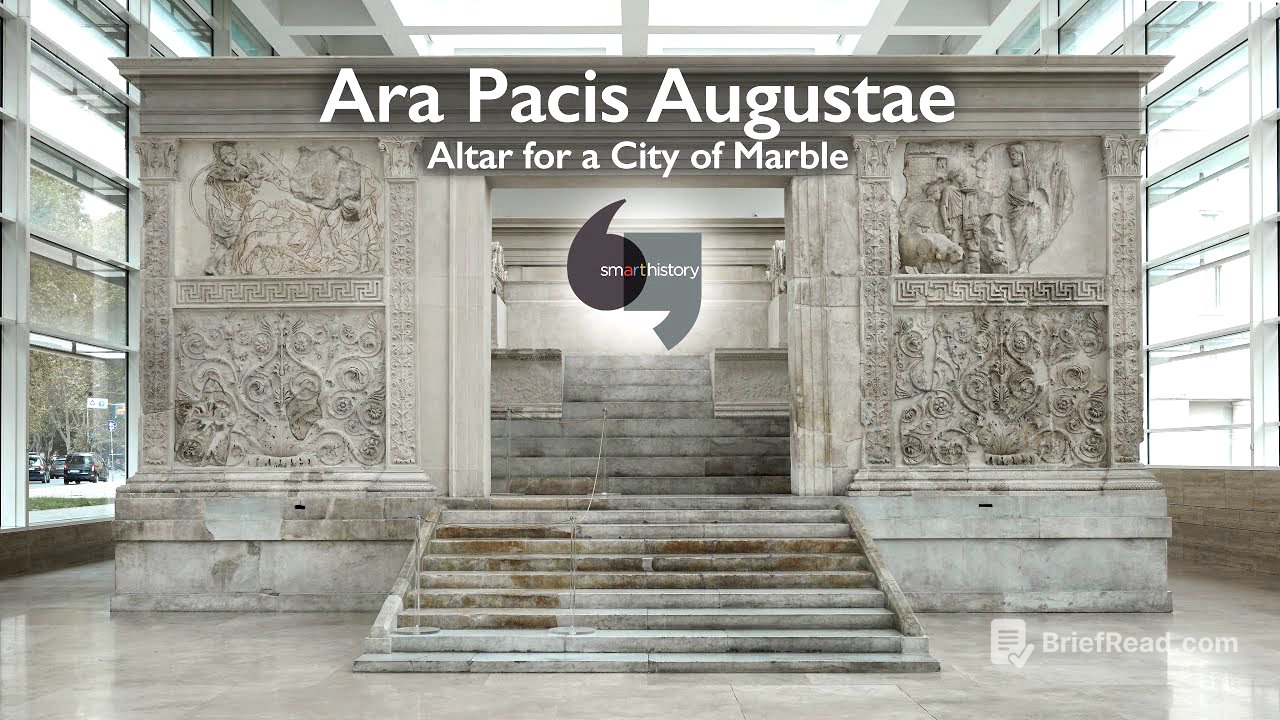TLDR;
This video explores the Ara Pacis Augustae, an altar dedicated to peace built by the Roman emperor Augustus. The altar was constructed to commemorate Augustus's triumphant return from military campaigns and the establishment of the Pax Romana, a period of peace and prosperity in the Roman Empire. The Ara Pacis is a significant example of Roman art and architecture, showcasing the transition from a city of brick to a city of marble. The video delves into the political and spiritual significance of the altar, highlighting Augustus's efforts to reestablish traditional Roman values while simultaneously transforming Rome into an imperial city.
- The Ara Pacis was built to commemorate Augustus's return from military campaigns and the establishment of the Pax Romana.
- The altar is a significant example of Roman art and architecture, showcasing the transition from a city of brick to a city of marble.
- The Ara Pacis holds political and spiritual significance, reflecting Augustus's efforts to reestablish traditional Roman values while transforming Rome into an imperial city.
The Ara Pacis Augustae: A Monument to Peace [0:00]
The video begins by introducing the Ara Pacis Augustae, an altar dedicated to peace built by the Roman emperor Augustus. The altar was constructed to commemorate Augustus's triumphant return from military campaigns in Spain and France, which led to the establishment of the Pax Romana, a period of peace and prosperity in the Roman Empire. The Ara Pacis was originally built in 13 BC and was later reconstructed from fragments discovered in the 17th and 20th centuries. The reconstruction was completed under Mussolini, who identified himself with Augustus and sought to re-establish a kind of Italian empire.
The Altar and Augustus's Power [1:30]
The video then focuses on the political and spiritual significance of the Ara Pacis. The altar itself is a symbol of Augustus's centralized power, as he sought to establish a new order in Rome after the assassination of his uncle, Julius Caesar. Augustus, whose real name was Octavian, was given the title "Augustus" to represent his power. He strategically gave power back to the Senate, but ultimately established himself as the first among equals, controlling all aspects of Roman life. He also held the title of head priest of the state religion, further solidifying his authority. The altar's construction reflects Augustus's desire to connect with the golden age of Greece and the Roman Republic, embracing traditional Roman values while simultaneously remaking Rome into an imperial city.
The Decorative Relief Carving [3:26]
The video then explores the decorative relief carving on the Ara Pacis. The lower freeze features over 50 different species of plants, rendered in a highly abstracted and symmetrical manner. The acanthus leaf, a native plant made famous in Corinthian capitals, is prominently featured, with tendrils of other plants spiraling upwards. The carving also includes animal forms, such as frogs, lizards, and birds. Art historians interpret these elements as symbols of fertility and abundance, representing the golden age that Augustus brought about.
The Narrative Friezes [4:50]
The video then examines the narrative friezes on the Ara Pacis. These friezes depict scenes related to the golden age established by Augustus, including references to Aeneas, the founder of Rome and Augustus's ancestor. Other allegorical figures representing Rome and peace are also featured. One panel, in particularly good condition, depicts a central figure, whose identity is debated among art historians. Some believe it represents Venus, others believe it represents the figure of peace, and still others believe it represents Tellus, or Mother Earth. Regardless of her identity, the figure clearly symbolizes fertility and abundance. She is accompanied by two children, two mythological figures representing the winds of the earth and the sea, and an ox and a sheep, alluding to harmony, peace, and fertility.
The Procession on the Sides [6:41]
The video concludes by discussing the procession depicted on the sides of the Ara Pacis. The freeze moves from the back wall of the precinct towards the front, with figures facing the main staircase. While the specific event depicted is unclear, art historians believe it may represent the inauguration of the altar. The figures in the procession include priests, members of Augustus's family, and possibly Augustus himself. The inclusion of children in the procession, even though it is a sacred and formal event, highlights the Roman emphasis on specificity and realism in portraiture. The video concludes by emphasizing the significance of the Ara Pacis as a testament to Augustus's vision for Rome, transforming it from a city of brick to a city of marble.
